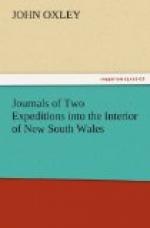October 27.—We did not make much progress this day, being greatly embarrassed by the thick brushes which border on the coast in the vicinity of Cape Hawke, and fresh water swamps near the edge of the lake. There was, however, a good deal of forest land, and the brushes grew in good soil. We halted in the afternoon, having gone only four miles (Cape Hawke bearing east distant two miles and a half), on a piece of forest land surrounded by brush, through which, however, in the course of the evening we cut a road to the beach, to the southward of Cape Hawke. From a hill on that line we saw that the lake was much more extensive than it was first supposed to be, reaching in a southerly direction to the base of the forest hills, which run a north-west line from the next point of south of Cape Hawke, and within a quarter of a mile of the beach. To the north-west we could trace it upwards of twenty miles, winding among forest hills and a generally fine looking country. The lake was studded with numerous islands of forest lands, the interior of the lake being apparently deep water with sandy beaches to the main and islands. The whole appearance of the lake was extremely picturesque and beautiful.
October 28.—This day’s journey afforded tolerably good travelling, with the exception of the last two miles, when, quitting the beach, we ascended a high hill over the lake, and again descended to a small bay under a point of land south of Cape Hawke, where we halted for the evening: having accomplished ten miles. Although we were obliged to halt the greater part of the day, the extreme heat of the weather, combined with the motion of the horse, rendered it impossible for our poor wounded man to proceed. From this point Cape Hawke bore North Peak on Ditto 357., highest part of the South Brother, N. 1. E.; North Brother, N. 7. E.; line of coast westerly, N. 306.; a point N. 328 1/2 mile; ditto N. 136 1/2. E.; ten or twelve chains islet of Sugarloaf Point, N. 168. The rocks off ditto, N. 173. Sugarloaf Point, 174 1/2.
October 29.—The coast projecting into bold and perpendicular headlands obliged us to keep at a distance from it, and travel over an elevated range, from whence we saw that an extensive series of lakes, probably forming one large one, continued at the back of the coast line nearly as far as Blackhead. At five miles we descended from the range on a small beach which terminated our day’s journey; the nature of the coast line preventing us from travelling along it. I therefore went with two men to mark out a road for the horses to the beach on the south-west side of Sugarloaf Point. The line we were obliged to pursue, led us through a most miserable scrubby country, formed into irregular steep hills of white sand, without a blade of grass, or herbage of any kind; but with abundance of small black butted gums, red gums, etc. We found the road across, to be too far for us to attempt this evening. Indeed it was near sunset when I returned to the tent.




